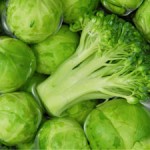 Broccoli has been called ‘nature’s perfect food’ as well as a ‘super-food’, and for good reason. Broccoli is high in several minerals, including calcium, magnesium, potassium and phosphorus. It is also packed with antioxidants and vitamins including quercetin, glutathione, lutein, indoles, vitamin A, vitamin B3, vitamin B5, beta-carotene, vitamin C, vitamin K, vitamin C and folic acid and has shown an incredible array of health benefits including lowering the list of cancer, primarily cancer of the colon, esophagus, larynx, lung, prostate, mouth, pharynx and stomach. These benefits are believed to be due to broccoli’s content of sulfur-rich compounds which help block cell mutations, stop the growth of tumors and help optimize hormone metabolism.
Broccoli has been called ‘nature’s perfect food’ as well as a ‘super-food’, and for good reason. Broccoli is high in several minerals, including calcium, magnesium, potassium and phosphorus. It is also packed with antioxidants and vitamins including quercetin, glutathione, lutein, indoles, vitamin A, vitamin B3, vitamin B5, beta-carotene, vitamin C, vitamin K, vitamin C and folic acid and has shown an incredible array of health benefits including lowering the list of cancer, primarily cancer of the colon, esophagus, larynx, lung, prostate, mouth, pharynx and stomach. These benefits are believed to be due to broccoli’s content of sulfur-rich compounds which help block cell mutations, stop the growth of tumors and help optimize hormone metabolism.
Vegetable cancer fighter
Broccoli contains a number of sulfur rich compounds, including sulforaphane, glutathione and glucarate. These compounds protect the body in several ways. First, research has shown that specific anti-estrogenic compounds called glucosinolates that are found in broccoli help reduce excess estrogen that has been linked to breast cancer. The sulforaphane in broccoli inhibits the formation and growth of cancer cells and has even been shown to be directly cytotoxic (i.e., deadly) to cancer cells.
In addition, the sulfur compounds found in broccoli support optimal detoxification, by giving the body the nutrients it needs to properly identify, neutralize and eliminate toxins and carcinogenic compounds from the body. Optimal detoxification is also necessary to keep our hormone levels in the proper balance.
Broccoli is also an excellent source of fiber, which helps cleanse the colon and keep the bowel regular. Once more, broccoli’s unique nutrient and fiber content means that it is an excellent way to support proper detoxification.
Buying and Preparing Broccoli
Buy broccoli that is vibrantly green and as fresh as possible; avoid broccoli that is yellow or dull colored. The beneficial sulfur compounds in broccoli decreases quickly with time, so the fresher the better. Steaming broccoli for a minute or so will bring out even more nutrients – take it off the heat when the color has gotten very intense, but it’s still crispy to maximize the nutrient content.
Brussel sprouts are the vegetable everybody seems to love to hate. I don’t know if it’s because too many people were forced to eat canned and/or overcooked Brussel sprouts when they were kids but if people dislike a vegetable, this is usually the one.
That’s unfortunate because Brussel sprouts are one of the healthiest foods you could possibly eat. Brussel sprouts are high in a number of key vitamins and minerals, including beta-carotene, vitamin B3, vitamin b6, vitamin C, vitamin E, folic acid, calcium, magnesium, potassium, iron and phosphorus. Along with broccoli, they have been shown to be protective against a number of different forms of cancer, including cancer of the colon, stomach, liver and breast.
In particular, studies have revealed the Brussel sprouts contain chemicals that help detoxify aflatoxin, a fungal mold linked to cancer, especially liver cancer. Aflatoxin is often found in peanuts, corn and rice and is a serious threat in third world countries. Studies have shown that animals fed high levels of Brussel sprouts or glucosinolates (the ingredient in Brussel sprouts that disarms aflatoxin), remained almost free of malignant liver tumors wen infected with aflatoxin. It appears that high concentrations of glucosinolates neutralized the cancer potential of the aflatoxin.
In addition, Brussel sprouts seem to possess a special affinity to support proper pancreatic function. In particular, it has been shown that the juice from Brussel sprouts helps regenerate and improve the insulin-producing capacity of the pancreas.
Buying and Preparing Brussel sprouts
Look for Brussel sprouts that are round, with densely packed leaves that are heavy for their size. If you pinch it there should not be any give; if it feels squishy or spongy, put it back. Once you get them home and are ready to cook, trim off a small amount of the end of the sprout. Peel off the outer leaves (if they don’t fall off when you cut off the end) until you see a slightly lighter green, clean, shiny leaves. Now you can steam or roast them whole or cut them in half. Cook them until they are warmed through, but not mushy.
